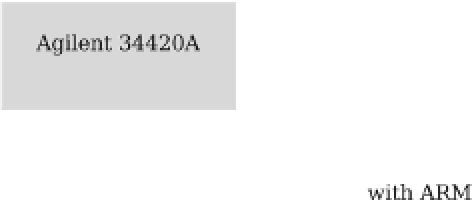Cryptography Reference
In-Depth Information
Fig. 16.1
Workbench used in order to accurately characterize the voltage range
Fig. 16.2
Workbench used to perform the error characterization and the attacks
tests were performed on two or more sample boards, reporting analogous results; for
the sake of clarity we present the results on a single board.
Two experimental workbenches were employed during this process: the first one,
aimed at producing a precise characterization of the effect of power supply lapses,
was endowed with a high-precision power supply; the second one, aimed at carrying
the attacks with a lower budget, employed less expensive equipment, without loss in
the efficacy of the attacks. The two workbenches are identical except for the change
in the Power Supply Unit (PSU).
The first workbench is depicted in Fig.
16.1
: the board was at first fed through an
Agilent E3631A PSU [4] with a precision of 1 mV, while on the second workbench,
depicted in Fig.
16.2
, it was fed through an Agilent 6633B [2] power supply with
0
01 V precision. In order to achieve rough sub-centivolt precision, we used a resistive
partitor with a common commercial grade resistor; whilst this solution does not
provide the same accuracy voltage control as using a high-precision PSU, it proved
effective enough to successfully implement all the attacks. All the voltage measures
were taken with an Agilent 34420A [3] voltmeter with a 1 nV precision probe, which
was already available to us; nonetheless the needed precision was only up to 0.5 mV.
.






















































